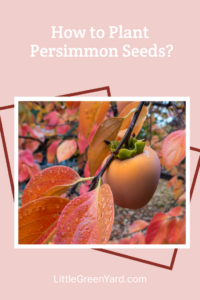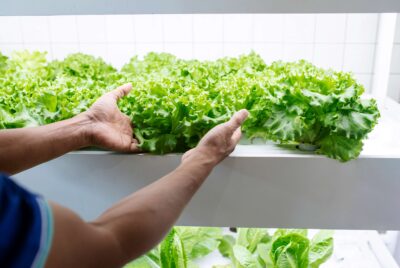How to Plant Persimmon Seeds?
Deprecated: The PSR-0 `Requests_...` class names in the Requests library are deprecated. Switch to the PSR-4 `WpOrg\Requests\...` class names at your earliest convenience. in /home/littlegr/public_html/wp-includes/class-requests.php on line 24
Hey there, fellow gardening enthusiasts! Today, I’m excited to delve into the wonderful world of planting persimmon seeds. If you’ve ever enjoyed the sweet and succulent flavors of a ripe persimmon, you might be wondering, “How can I grow my very own persimmon tree from seeds?” Well, you’re in for a treat! In this guide, I’ll walk you through each step of the process, from gathering the seeds to nurturing your young seedlings into thriving trees. So, let’s roll up our sleeves and embark on this rewarding gardening journey together!
What is a Persimmon?
Persimmons are a fruit from a tree related to the date plum, the black sapote, and the mabolo. Most cultivated persimmons are variants of the species Diospyros kaki, which is native to China but also grown in other parts of Asia such as Japan, Myanmar, the Himalayas, and parts of northern India. There’s also a second species of persimmon, Diospyros virginiana, which is native to the Eastern United States, and the fruit is smaller than the Asian species.
Gathering Persimmon Seeds
To begin our adventure, we need the star of the show: persimmon seeds. When you indulge in a juicy persimmon, set aside those seeds for planting. Remember that the variety of persimmon will play a role in whether it will have seeds or not. Persimmons come in various delectable varieties, each offering unique flavors and characteristics. There are two primary varieties of persimmons;
Fuyu Persimmon: (Diospyros kaki): The Fuyu persimmon is one of the most widely recognized varieties. It’s known for its squat, tomato-like shape and vibrant orange color. Fuyu persimmons are crisp even when fully ripe, making them a perfect snack. They have a sweet, honey-like flavor and are often enjoyed fresh or added to salads.
Hachiya Persimmon: (Diospyros virginiana): Hachiya persimmons are distinguished by their acorn-like shape and rich, deep orange hue. They are known for their astringent nature when unripe, which means they’re incredibly bitter until fully ripe. Once ripe, Hachiya persimmons turn soft and have a smooth, custard-like texture. They are great for baking, making jams, and creating sweet treats.
However, not all varieties produce seeds. If you’re not keen on dealing with seeds, opt for seedless varieties like the Fuyu persimmon. These cultivars are propagated through grafting or budding, ensuring that you’ll enjoy the fruit without the hassle of seeds. If the persimmons found in your local grocery shops are all seedless varieties, then you can also purchase the seeds online from a distributor.
Preparing the Persimmon Seeds for Planting
For those ready to embrace the seed-planting process, let’s dive into preparing the seeds for optimal germination success.
Seed Cleaning and Storage
If you got your persimmon seeds from a fresh fruit, before planting, give your seeds a gentle cleaning to remove any clinging fruit flesh. Then, store them in a cool, dry place until you’re ready to stratify.
Stratification Process
Stratification mimics the natural winter conditions that encourage germination in persimmon seeds. It involves subjecting the seeds to cold temperatures to break their dormancy, tricking the seeds into thinking they’ve experienced winter, prompting them to prepare for spring growth. Persimmon seeds require a period of stratification to encourage uniform and successful germination.
For the stratification process, select a suitable container with a lid and make sure it is well ventilated but at the same time, retaining the moisture within. Place a moist stratification medium in the container. You can use materials like damp peat moss, vermiculite, or paper towels. The medium should be damp but not soaking wet. Place the cleaned persimmon seeds into the stratification medium. Ensure they are evenly spaced and not overcrowded. Close the container to prevent medium from drying out.
Place the container in the refrigerator’s vegetable crisper drawer. The temperature should be consistently around 32 to 41 degrees Fahrenheit (0 to 5 degrees Celsius). Check the stratification medium periodically to ensure it remains damp. If it starts to dry out, lightly mist it with water. The duration of stratification varies depending on the persimmon variety, but it typically ranges from 60 to 90 days. Research the specific requirements of the persimmon variety you’re working with.
After the stratification period, remove the seeds from the refrigerator. Allow them to gradually acclimate to room temperature by placing them in a cool, shaded area for a few days. Inspect the seeds for signs of germination – usually evidenced by the emergence of a small root. Once germination occurs, plant the seeds in a suitable growing medium, following proper planting guidelines.

Planting Persimmon Seeds
With stratified seeds in hand, it’s time to plant them!
Select a sunny spot in your garden with well-draining soil. Persimmons thrive in full sunlight and benefit from protection against strong winds. Prepare the planting area by loosening the soil and incorporating organic matter. This sets the stage for healthy root development. Plant the seeds about an inch deep in the soil and space them a few inches apart. This gives the seedlings room to grow and spread their roots.
As your persimmon seedlings emerge, they’ll need some tender loving care to flourish into strong trees. Keep the soil consistently moist but not waterlogged during the early stages. Apply a balanced fertilizer to provide essential nutrients. Shield your seedlings from potential threats like aphids and fungal diseases. Regular monitoring and appropriate treatments are essential.
Guide the growth of your persimmon tree by pruning away any weak or crossing branches. This encourages a sturdy and productive tree structure.
Watching Your Persimmon Tree Grow
As the seasons unfold, you’ll witness the transformation of your young saplings into big persimmon trees. Growing persimmons requires patience. Be diligent in watering, fertilizing, and protecting your trees as they mature.
The time it takes for a persimmon tree to reach maturity and begin producing fruit can vary based on several factors, including the specific variety of persimmon, growing conditions, care practices, and whether the tree was grown from seeds or grafted. On average, you can expect the following timelines:
- Persimmon Trees Grown from Grafted Saplings: If you start with a grafted sapling, which is a young tree already derived from a mature, fruit-bearing variety, you can typically expect to see your persimmon tree producing fruit within 2 to 3 years after planting. Grafted trees are already established and have a head start on growth and development.
- Persimmon Trees Grown from Seeds: Growing persimmon trees from seeds takes longer to reach fruit-bearing maturity. It’s common for persimmon trees grown from seeds to take around 5 to 7 years or even more before they begin to produce fruit. This is because seed-grown trees need to go through several stages of growth, including seed germination, establishment as a seedling, growth into a young tree, and finally, the development of flowers and fruit.
FAQs about Planting Persimmon Seeds
Can I plant persimmon seeds directly from the fruit? While it’s possible, stratifying the seeds significantly enhances germination rates. Cold treatment breaks dormancy and jumpstarts growth.
How long does it take for persimmon seeds to germinate? On average, persimmon seeds take several weeks to a few months to germinate. Patience is key!
Do all persimmon varieties have seeds? No, some persimmon varieties, like Fuyu, are seedless and propagate through grafting.
Should I stratify persimmon seeds before planting? Yes, stratification improves germination success by simulating winter conditions.
Can I grow a persimmon tree in a container? Certainly! Choose a dwarf variety and provide a spacious container for optimal growth.
Last words
I love eating persimmons because they are sweet, juicy and crunchy! Plus, they are one of the more exotic fruits that are only available during Fall. From Germany, most of the persimmons are imported from Spain. But in Asian supermarkets, you’ll be able to try the dried versions.
Watch this from one of my favorite Youtubers on how she dries and preps her persimmons!




